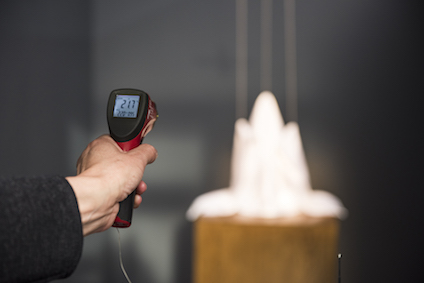
Understanding the Unknown – GHost Hosting and the formula for scientific truth
By Eibhlín Kissack
Ghosts provide the perfect metaphor to explore ‘beyond’ the world of human experience. But why is popular culture so fascinated with the ambiguous void between the states of life and death?
In her ambitious project, Sarah Sparkes explores the the nature of ghosts, ghost theories and the platforms upon which ghosts are manifested. Sparkes interrogates the idea of the ghost through a series of Hostings which explore the relevance of ghosts in contemporary culture, and through a Visual Arts Programme that aims to explore ghost-making through a variety of exhibitions and screenings. She will continue to explore the technology and psychology inherent in ghost-making in the upcoming event GHost Hosting 16: Ghost-making machines, taking place in Williamson Tunnels Heritage Centre on Friday 16 December.
Sparkes’ project relates to the realm of the unknown, and our collective human attempts to understand areas of mysticism. The idea of uncertainty and questioning is prevalent here, relating to collective cultural thinking surrounding the uncanny.
In light of Sparkes’ project, I would like to consider why ghostly encounters are often devoid of scientific explanation. In artistic practice, subjective opinion largely determines whether art is ‘good’ or ‘bad’ on a personal level. Yet, in scientific practice who truly holds the authority to determine what counts as ‘factual’ scientific theory? Where do we look for the truth? Paranormal research groups, psychologists, and personal accounts of experiences of ghosts all contribute to the ‘narrative of the ghost’ – however, there is no concrete theory to understand the unknown. Perhaps the reason for this is due to the vastly different cultural understandings of the uncanny; there is no sole or singular idea of the ghost – it arises in many pluralities.
Ghosts transcend national boundaries and manifest in a variety of ways depending on cultural factors, periods in history and subjective experience. The one reoccurring element that links various depictions of ghosts across the globe is the idea of faith. Without some level of faith in the idea of the ghost and the supernatural, we are unable to fully explore the realm of the unknown.
As part of her series of Hostings, Sparkes held a performance event at FACT entitled GHost Hosting 15: Day of the Dead that explored the idea of a ‘formula for ghost making’. The session illustrated some of the ways in which ghosts have been celebrated internationally. Dr Niamh Thornton spoke of the ways in which Latin American history has embraced the idea of the ghost in celebrations such as the annual Day of the Dead festival. Thornton linked Latin American notions of spirituality to popular culture, exploring the ways that film has often represented spirits and ghosts.
The human fascination with the uncanny becomes clear through the presentation of ghosts in popular culture throughout history. Right back to the Renaissance period ghosts appeared in various forms of popular culture – several of Shakespeare’s plays focus on the realm of the uncanny and features frequent sightings of ghostly figures (such as those in Hamlet and Macbeth). During the Victorian era, Spiritualism became popular – encouraging communication with the dead through ghost hosting events and mediums. The ‘ghost story’ has become a popular narrative trait for hundreds of novels and films throughout history and it has even become popular to embark upon ghost-story night walks in cities across the world.
It is clear to see how the idea of ghostly presences vary when looking at the different characteristics attributed to ghosts in film and television. Ghosts have embodied starkly different physical manifestations; from the child-friendly cartoon Casper (1995), to the heart-throb Patrick Swayze in Ghost (1990) and the terrifying ghosts in Sigaw (2004) and El espinazo del diablo (2001).
Ghosts challenge our understanding and systems of belief as they eerily occupy the world of the living and the world of the dead simultaneously. As the ‘unknown’ and supernatural realm is understood in so many different contexts and cultures, a singular solid theory of ghostly presences can perhaps never be achieved. Yet, the idea of the ghost will continue to be interrogated in a variety of mediums despite a lack of factual scientific evidence – new meanings and explanations will continue to be applied to apparitions of ‘the ghost’ and contribute to the ever-expanding narrative of the ‘unknown’ in human experience.
Join Sarah Sparkes on Friday 16 December 6.30pm – 8.30pm at the Williamson Tunnels Heritage Centre for the free event Ghost Hosting 16: Ghost-making machines. Book your place here.
Image credit: The GHost Tunnel, Sarah Sparkes, 2016, mixed media installation. Williamson Tunnels Heritage Centre and FACT.
SOURCE : http://www.fact.co.uk/news-articles/2016/12/understanding-the-unknown-ghost-hosting-and-the-formula-for-scientific-truth.aspx
